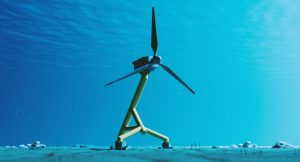
New turbine blade pitch control technology for use in renewable energy applications.
This technology enables the independent passive pitching of individual turbine blades in response to uneven and variable loading. When compared with state-of-the-art solutions, it offers high resilience and reliability by reducing the unsteady loading and limiting the maximum power at rated flow velocity on tidal turbines with the potential to significantly decrease the levelized cost of energy production.
Application
Development Status
IP Status
International (PCT) Patent Application
Commercial Offerings
Opportunity
The potential of tidal energy to contribute to future energy decarbonisation strategy as a predictable renewable source is substantial. To realise this, however, advancements in technology are required to reduce the levelized cost of energy and enhance the competitiveness of these sectors in the energy market.
A key aspect where technology can make a difference is by mitigating hydrodynamic load fluctuations, and controlling the maximum power transmitted to the generator, thereby enhancing operational efficiency and also increasing the turbine's fatigue life.
One such approach is to deploy blade pitching mechanisms that mitigate exposure to varying loads. However, current methods for pitching control typically rely on active mechanisms that are not desirable in harsh environments, are limited to low-frequency fluctuations, are costly and require high maintenance.
Technology Overview
To address this, Professor Viola and colleagues at the University of Edinburgh have developed a new mechanical solution to control the pitching of blades. The Edinburgh technology enables individual blades of a turbine system to passively pitch in response to instantaneous loads.
This is achieved through an assembly that allows a turbine blade to pitch around a spanwise axis, with the pitching motion being constrained by a torsional spring. It can either be used in addition to pitch control systems to enhance unsteady loading mitigation, particularly at high frequency, or can entirely substitute active pitch systems by controlling only the turbine speed.
The mechanism is agnostic of blade design, so suitable for use with existing and future systems. Importantly the implementation is mechanically simple and does not include active components or complex linkages making it inherently durable and offering the potential for higher resilience, better reliability, longer lifetimes, lower susceptibility to structural fatigue and ultimately reducing the levelized cost of energy.
Benefits
Independent pitching of individual blades in response to localised loading conditions
Projected to decrease levelized cost of energy by more than 10%
Applicable to most blade designs
Suitable for retro-fitting to existing blades, as well as new blade designs
Publications
https://VOILAb.eng.ed.ac.uk/publications#Energy
Please note, the header image is purely illustrative. Source: imaginima via GettyImages
Quote: TEC1104494

Senior Technology Transfer Manager
School of Engineering